HUAWEI HiCar 4.0 released: the deep integration of mobile phones and cars, opening up a new smart travel experience with the Internet of Everything
On August 5, 2023, the 2023 Huawei Smart Travel Ecological Summit was successfully held. Huawei officially released HUAWEI HiCar 4.0, with deep integration with automobiles as the core highlight, bringing new and upgraded seamless smart travel solutions to car companies. At the press conference, Xu Jingjin, general manager of Huawei’s end point BG smart travel, and representatives of ten automotive industry partners held the HUAWEI HiCar 4.0 ecological launch ceremony, and will start a new journey of HUAWEI HiCar 4.0 with excellent partners in the automotive industry.
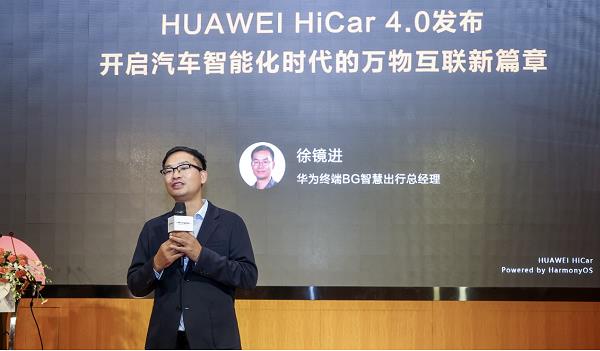
HUAWEI HiCar 4.0 Released
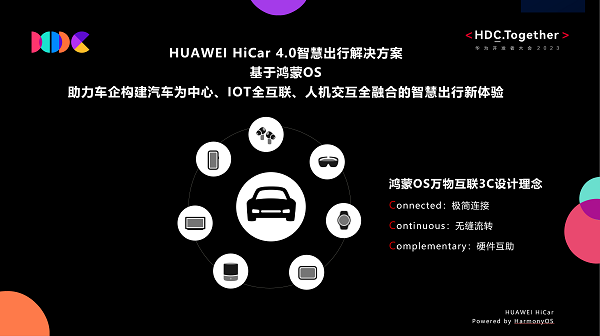
HUAWEI HiCar 4.0, based on HarmonyOS 4.0, helps vehicles become intelligent and realizes a new smart travel experience with full integration of IoT and human-machine interaction. The design concept of cross-device experience can be simply summarized as "three Cs".
1. Minimalist connection: including one-step connection, extremely fast connection, stable and reliable connection, etc., just like building a highway between a mobile phone and a car.
2, seamless flow Continuous: the tasks on the personal end point device can be transferred to the car to continue working, such as watching movies, making phone calls, listening to songs and navigation, etc., to experience the seamless flow between devices;
3. Hardware Mutual Assistance Complementary: Each device has the best ability, and the devices can complement each other’s advantages and hardware mutual assistance.
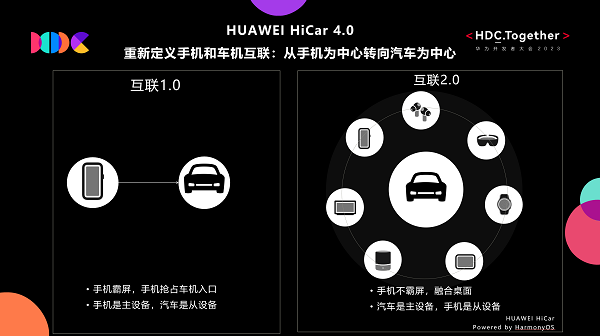
The release of HUAWEI HiCar 4.0 symbolizes that the interconnection of mobile phones and cars and machines has entered the 2.0 era, and will move from interconnection to mutual integration. In the past, the interconnection mode and experience of mobile phones, cars and machines were mainly screen projection, which was reasonable in the state of insufficient capacity of the old generation of cars and machines, but it is no longer in line with the development trend of the new generation of smart cars and machines. The current car has developed to the smart cockpit, and the end point needs a more integrated and collaborative way to promote the cockpit to be more intelligent, and the human-machine interaction is more concise and unified, rather than a simple screen projection.
In the era of intelligence, smartphones and smart cars, as the two largest super intelligent end points, are connected at the system level, ecological sharing, and hardware mutual assistance, bringing consumers a collaborative experience of 1 + 1 > 2. In the smart travel scenario, the car is the largest smart IoT device. In addition to mobile phones, consumers’ personal smart devices may also have smart watches, smart glasses, etc., and rear passengers may also use laptops or PADs for office work, or watch movies through AR/VR glasses. These personal smart devices will gradually cooperate seamlessly with the car cockpit in the future, creating a new smart cockpit experience of multi-device collaboration across devices and scenarios.
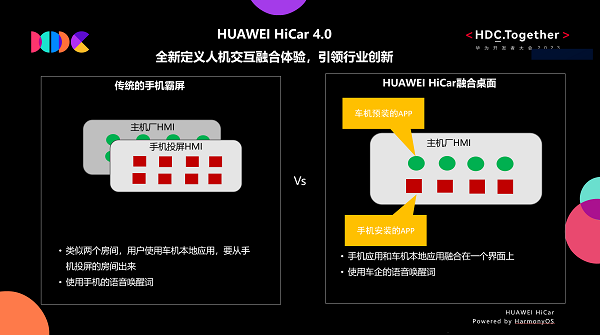
Mobile phones and cars are moving from interconnection to mutual integration, which is mainly reflected in four aspects:
1. Interactive integration
A) Human-machine interaction is the first entrance to the user experience. What users need is simple and easy to use, one step directly; using the local application of the car and the application on the mobile phone should not be separated in the interaction experience, including interaction steps, UI layout, voice interaction, and fluency.
B) The previous generation of mobile screen projection interface and the native interface of the car machine are two different interface designs, which increase the learning cost for consumers. The traditional Internet screen projection mode is similar to two rooms. Users usually use mobile screen projection applications in one room. If they want to use the local application of the car machine, they have to change from the room where the mobile phone is projected to another room. This requires about 3 to 5 steps, which is cumbersome and unsafe for users.
C) HUAWEI HiCar4.0 integration solution realizes the integration of mobile phone applications and car-machine local applications on a HMI interface, and the primary and secondary are clear. At this time, the car is the owner, the mobile phone is the guest, and the guests are seated in an orderly manner according to the host’s ranking. That is to say, the application from the mobile phone and the native application of the car-machine are interactively integrated in an orderly manner, so as to achieve a unified human-machine interaction experience.
D) In terms of intelligent voice interaction, in the traditional mode, if you want to operate the mobile phone application by voice, you must use the wake word of the mobile phone, while if you operate the car application, consumers need to use the car Keyword Spotting, which is not only fragmented in the user experience, but also increases the difficulty of use. In the HUAWEI HiCar 4.0 integration mode, the gap between the voice experience will be broken.
2. Application integration, HUAWEI HiCar can realize more applications on the bus. Through application integration, the car and machine can share the mobile application ecosystem.
3, data fusion, under the premise of meeting user privacy data protection, the integration of personal data on personal intelligent end point devices and car data can create more useful, interesting and innovative new scenarios.
4. Hardware mutual aid integration, the car has a powerful and professional hardware configuration, personal end point devices also have many sensors and actuators, these hardware capabilities are integrated and mutual aid, just like King Kong gourd baby, each intelligent end point device is like a gourd baby, some are "clairvoyant", some are "tailwind ear", 7 gourd baby combined can form a super gourd baby, to achieve powerful functions that a single device cannot do.
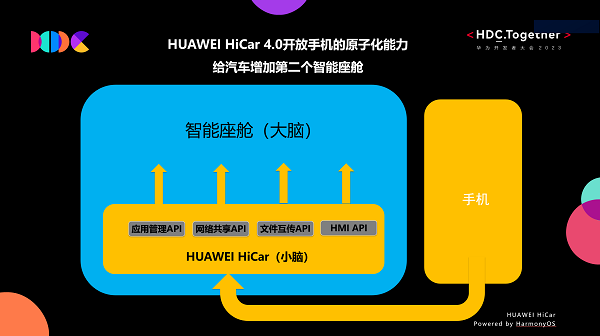
In terms of architecture, the smart cockpit is the brain of the car. The car side realizes the effect of increasing the cerebellum by pre-installing the HUAWEI HiCar plug-in, and commands and schedules the mobile phone resources. Due to the SOA architecture transformation of the mobile phone, a rich application ecosystem and hardware resources can be opened to the smart cockpit in the form of APIs. When the cockpit carries out intelligent innovation, it can not only be limited to the hardware resources and resource applications of a single device in the cockpit, but also call the second host – the mobile phone, which is equivalent to the "sixth domain" of the car.
On August 1, the China Association of Automobile Manufacturers and the China Academy of Information and Communications Technology under the guidance of the Intelligent Vehicle Connection Industry Ecological Alliance (ICCE) released the "Mobile Phone-Car Connection Performance Experience Evaluation Report" (hereinafter referred to as the "Evaluation Report") in Beijing. The evaluation report focuses on 5 major experience scenarios and 11 experience indicators that industry partners focus on, and randomly selects 6 vehicles for evaluation in combination with mainstream mobile phone-car interconnection solutions. Among them, HUAWEI HiCar has a comprehensive score of 96.63 points, ranking first in terms of fast wireless connection, smooth audio output and accurate voice interaction.
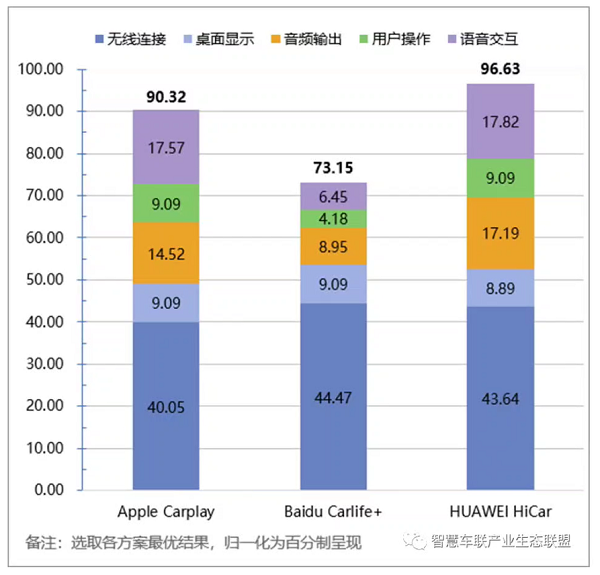
So far, HUAWEI HiCar has supported more than 30 car brands, more than 400 models and more than 1,600 new cars, and has received the support of many car companies. It will soon meet with consumers one after another. Let’s wait and see.
mobile.zol.com.cn
True
https://mobile.zol.com.cn/828/8287375.html
Report
3857
On August 5, 2023, the 2023 Huawei Smart Travel Ecosystem Summit was successfully held. Huawei officially released HUAWEI HiCar 4.0, with the deep integration of mobile phones and automobiles as the core highlight, bringing new and upgraded people, cars, and seamless smart travel solutions to car companies. At the press conference, Xu Jingjin, general manager of Huawei’s end point BG smart travel, and representatives of ten automotive industry partners carried out HUAWEI HiCar…